Hidden within the Bible's pages, Elam's ancient legacy unveils a map of intrigue and historical significance.
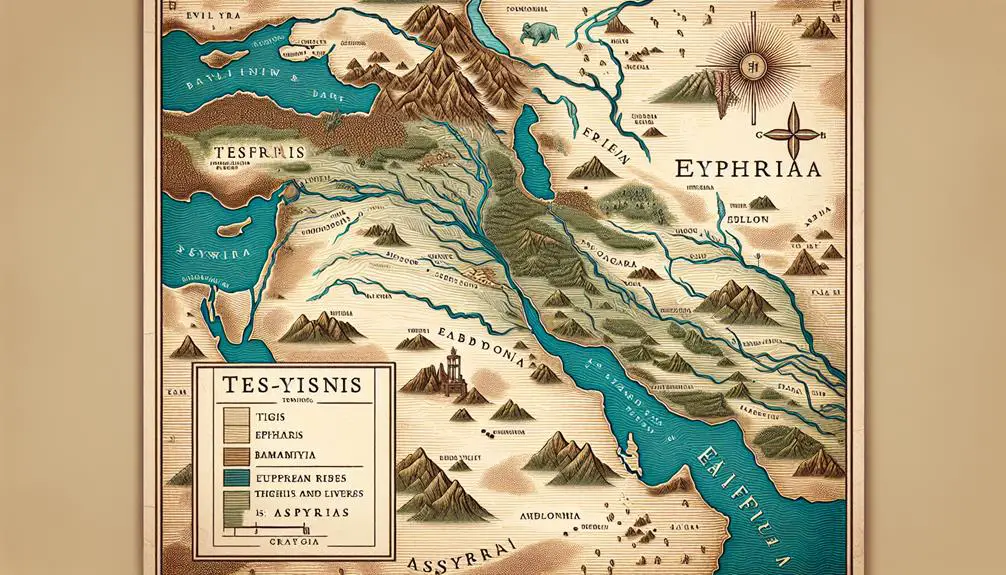
Elam in the Bible Map
Have you ever wondered about the significance of Elam in the biblical narrative?
This ancient civilization, nestled beside the powerful empires of Mesopotamia, plays a more crucial role than you might initially think.
Elam's presence in the Bible, from Genesis to the prophetic books, offers a fascinating glimpse into its historical geography, political alliances, and cultural impact.
As you explore Elam's legacy within the biblical context, you'll find intriguing connections that shed light on its enduring influence in the ancient world.
Let's uncover the layers of history and mystery that Elam contributes to the biblical map, leaving its mark for us to trace.
Key Takeaways
- Elam's strategic location facilitated cultural and military interactions detailed in biblical narratives, including its mention in prophecies.
- Susa, Elam's capital, exemplifies the region's significance in biblical geography and ancient geopolitics.
- Biblical references to Elam, including its destruction as prophesied by Jeremiah, highlight its importance in divine narratives.
- Elam's historical and cultural context enriches understanding of its role in biblical maps and narratives.
Historical Geography of Elam
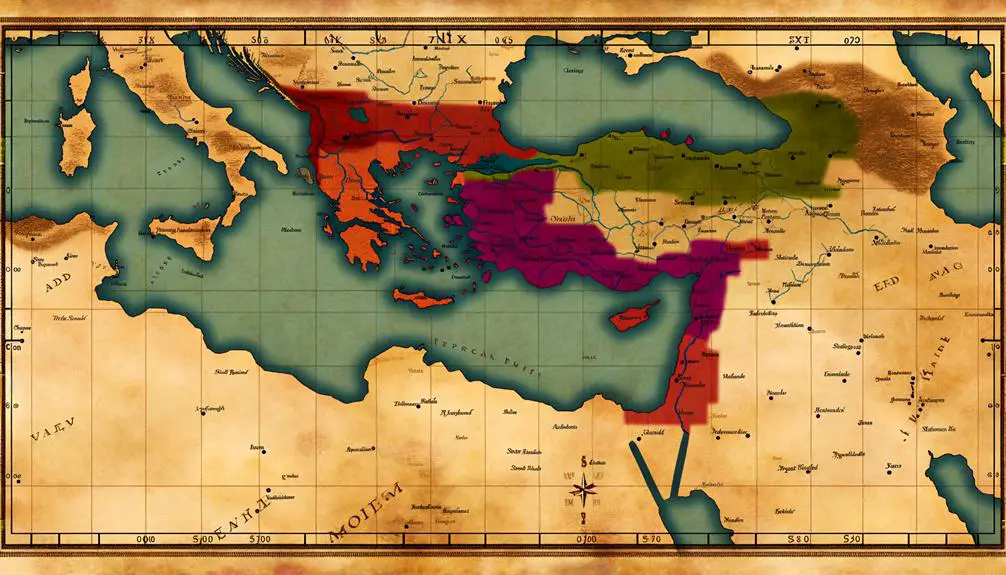
Elam's geographical landscape, a testament to its historical significance, stretched across the Zagros Mountains in what's now southwestern Iran, marking it as a pivotal region in ancient Near Eastern history. This territory, rich in resources and strategically located, played a crucial role in the development and preservation of what you know as Elamite culture. Through careful analysis of Elamite artifacts unearthed in this region, particularly those from its capital, Susa, you gain profound insights into the complexities of Elam's societal structures, religious practices, and interactions with neighboring civilizations.
The Susa capital, often featured prominently in scholarly discussions, serves as a focal point for understanding the broader Elamite civilization. Its archaeological remains, including monumental architecture and intricate reliefs, provide tangible evidence of Elam's sophistication and influence. You must appreciate how these artifacts, coupled with the geographical advantages offered by the Zagros Mountains, facilitated Elam's rise as a formidable power in the ancient Near East. The mountains not only provided a natural defense barrier but also supported a diverse ecosystem that contributed to Elam's economic sustainability.
In dissecting the historical geography of Elam, you're encouraged to consider the strategic placement of Susa within the Elamite domain. Its location on the edge of the Iranian plateau enabled it to act as a cultural and commercial bridge between the civilizations of the Mesopotamian plains and the Iranian highlands. This unique position allowed Elam to absorb, adapt, and disseminate a wide range of cultural influences, which are reflected in the diverse nature of Elamite artifacts. Through a scholarly lens, these insights underscore the significance of Elam's geographical landscape in shaping its historical trajectory.
Elam in Genesis: Abraham's Era
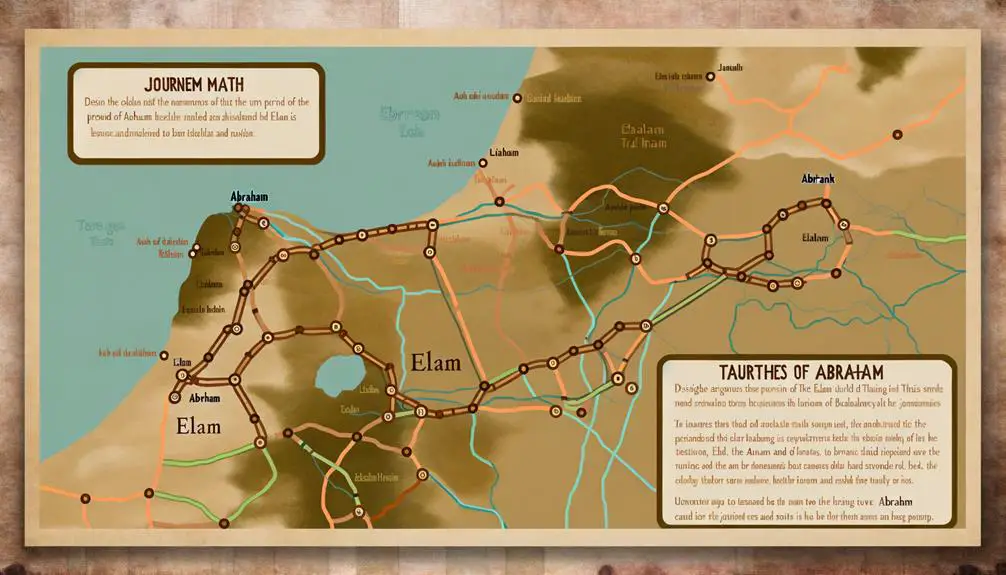
In the Book of Genesis, Abraham's era introduces us to a pivotal moment where Elam, under King Chedorlaomer, emerges as a dominant force, showcasing its political and military influence in the ancient Near East. This period is crucial for understanding the Elamite origins and their interaction with surrounding civilizations, including their engagement in Abraham's journey.
The narrative surrounding Abraham and the Kingdom of Elam provides a fascinating glimpse into the geopolitical dynamics of the time. Elam's aggressive expansions and its king's involvement in the Battle of the Kings highlight the strategic importance of the region. Abraham's encounter with Chedorlaomer and the subsequent rescue of his nephew Lot underline the complexities of alliances and conflicts that characterized the ancient Near East.
Aspect |
Emotional Impact |
|---|---|
Elamite Military Prowess |
Instills awe and respect for Elam's formidable power and strategic acumen. |
Abraham's Courageous Rescue |
Evokes admiration for Abraham's bravery and loyalty to family. |
Elamite Origins |
Sparks curiosity about the ancient roots and cultural heritage of Elam. |
Interactions with Abraham |
Fosters a deeper understanding of the interconnectedness of ancient peoples and the significance of their narratives. |
Analyzing these events through a scholarly lens, we appreciate the historical and cultural layers that define Elam's role in Genesis. The Elamite origins, tied intricately to Abraham's journey, offer rich insights into the early interactions that shaped the course of biblical history. These episodes not only enhance our understanding of the ancient world but also enrich the tapestry of narratives that form the backdrop of biblical events.
Prophetic References to Elam
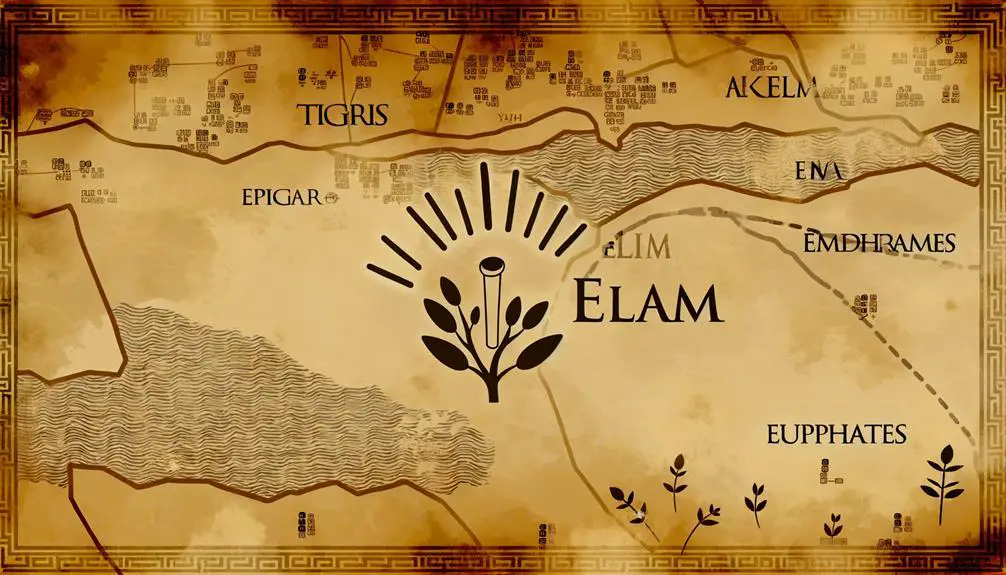
You'll find that the prophetic landscape of the Bible intricately maps out Elam's destiny, particularly through the lens of Jeremiah's oracle.
This segment highlights Elam's envisaged role in end times, a topic that stirs both scholarly debate and theological reflection.
Elam's End Times Role
Biblical prophecies vividly depict Elam's role in the end times, highlighting its significant yet complex position within eschatological narratives. Scholars delve into Elamite artifacts and modern interpretations to unravel this ancient civilization's prophesied fate.
These artifacts, ranging from inscriptions to pottery, serve as tangible links to Elam's storied past, while contemporary exegesis offers fresh perspectives on its prophetic implications. The analysis of such artifacts, coupled with modern scholarly interpretations, sheds light on Elam's predicted involvement in end times scenarios.
This nuanced approach underscores the importance of archaeological findings and contemporary theological insights in understanding Elam's eschatological role. Through this lens, you grasp the multifaceted nature of Elam's destiny as foretold by biblical prophecy, enriching your comprehension of its place in the tapestry of end times events.
Jeremiah's Oracle on Elam
Building on the understanding of Elam's eschatological significance, let's now examine Jeremiah's oracle on Elam, a critical piece of prophetic literature that further illuminates this ancient civilization's role in biblical prophecy.
Jeremiah's visions, dense with symbolic imagery, foretell Elam's destruction in striking detail. This prophecy, articulated in Jeremiah 49:34-39, functions not only as a prediction but also as a theological reflection on divine justice and the transitory nature of political powers.
The oracle suggests that despite Elam's might and its strategic position, it isn't immune to divine judgment. Jeremiah meticulously outlines the stages of Elam's downfall, from the breaking of its bow—symbolizing the loss of military power—to the dispersion of its people, highlighting the comprehensive nature of its defeat.
This analysis underscores the fragile balance between earthly dominion and divine sovereignty.
Elam's Political Alliances
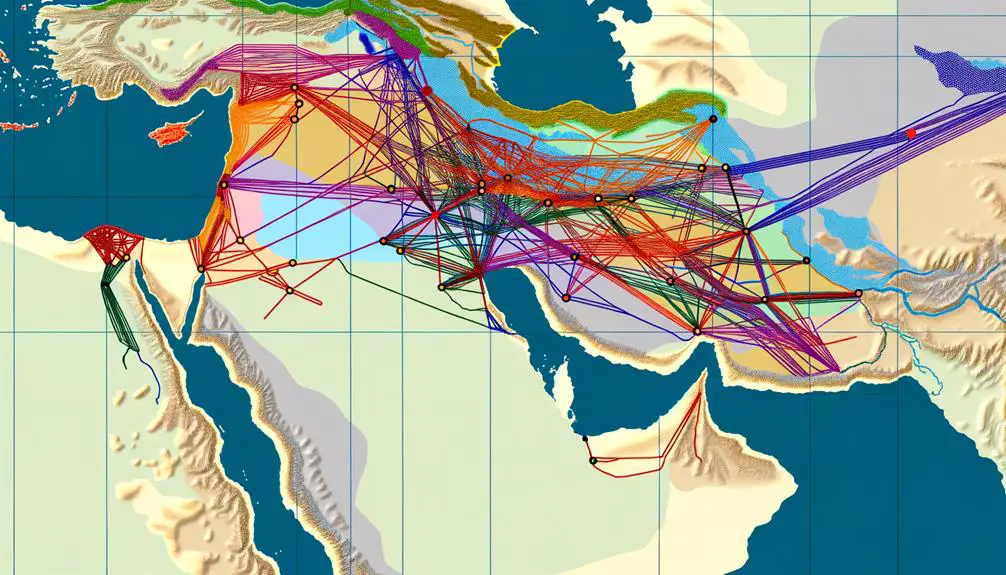
ARTICLE TITLE: Elam in the Bible Map
PREVIOUS SUBTOPIC: 'Jeremiah's Oracle on Elam'
CURRENT SUBTOPIC: 'Elam's Political Alliances'
Throughout history, Elam engaged in various political alliances, often driven by strategic interests and regional power dynamics. These alliances, established through both trade networks and military conflicts, played crucial roles in shaping the geopolitical landscape of the ancient Near East. You'll find that Elam's position, both geographically and politically, provided it with unique opportunities to influence trade routes and engage in significant military campaigns.
Analyzing Elam's alliances, it's evident how these relationships were influenced by two primary factors: trade networks and military conflicts. Trade networks facilitated not only economic prosperity but also cultural exchanges and diplomatic ties. On the other hand, military conflicts often led to shifting alliances, as Elam sought to either defend its territories or expand its influence.
To emphasize the interconnectedness between Elam's trade and military engagements, consider the following table:
Factor |
Influence on Alliances |
Examples |
|---|---|---|
Trade Networks |
Economic Prosperity |
Mesopotamia, Indus Valley |
Military Conflicts |
Territorial Defense/Expansion |
Battles against Assyria |
Geopolitical Position |
Diplomacy & Influence |
Medes, Babylonians |
This table underscores how Elam's strategic location and political maneuvers through trade and military might allowed it to forge alliances that were pivotal in its historical narrative. Such an analytical view provides a clearer understanding of the complexity behind Elam's political alliances, revealing a sophisticated interplay of economics, military strategy, and diplomacy.
Cultural and Religious Impact
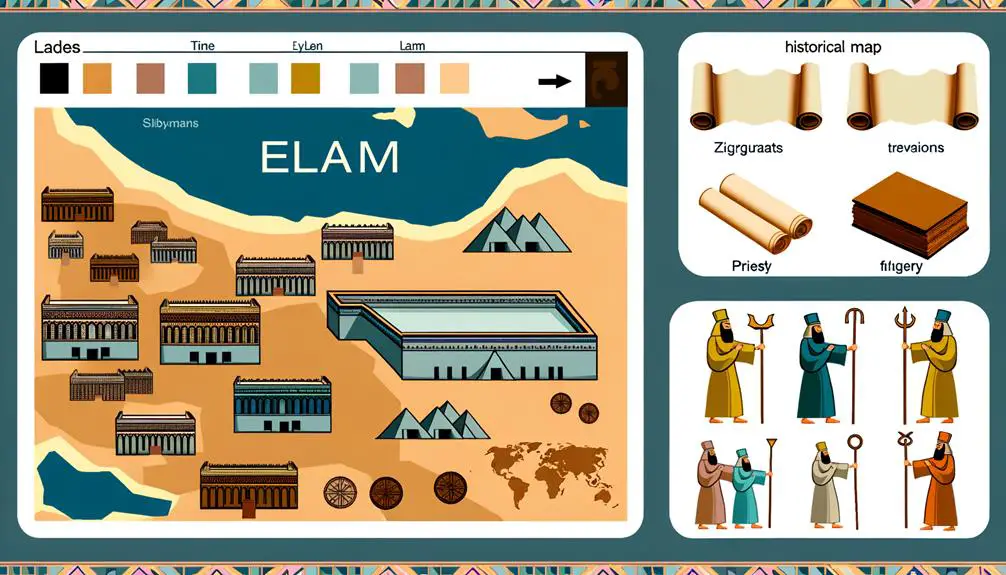
Through its extensive trade networks and political alliances, Elam significantly influenced the cultural and religious landscapes of the ancient Near East. This influence is evident when you delve into the rich tapestry of Elamite artifacts and their modern interpretations. These artifacts not only provide a glimpse into Elamite society but also showcase the complex interplay between cultures in the ancient world.
To create a vivid image in your mind, consider these aspects of Elamite cultural and religious impact:
- Art and Architecture: Elamite ziggurats and temples, with their intricate designs and innovative constructions, inspired neighboring civilizations. The use of glazed bricks and the emphasis on monumental statuary became hallmarks that were emulated across the region.
- Language and Script: The adoption and adaptation of the Elamite cuneiform script by surrounding cultures facilitated the spread of ideas and religious concepts. This script became a bridge for cultural exchange and intellectual discourse.
- Rituals and Religious Practices: Elamite religious ceremonies, which often involved complex rituals and offerings, influenced the spiritual practices of its neighbors. The reverence for gods such as Inshushinak is reflected in the syncretism observed in the religious life of the ancient Near East.
- Trade and Cultural Exchange: Through trade, Elam exported not only goods but also cultural and religious ideas. This exchange led to the assimilation of Elamite deities into other pantheons, and the spread of artistic motifs and technological innovations.
Elam's Legacy in Biblical Context
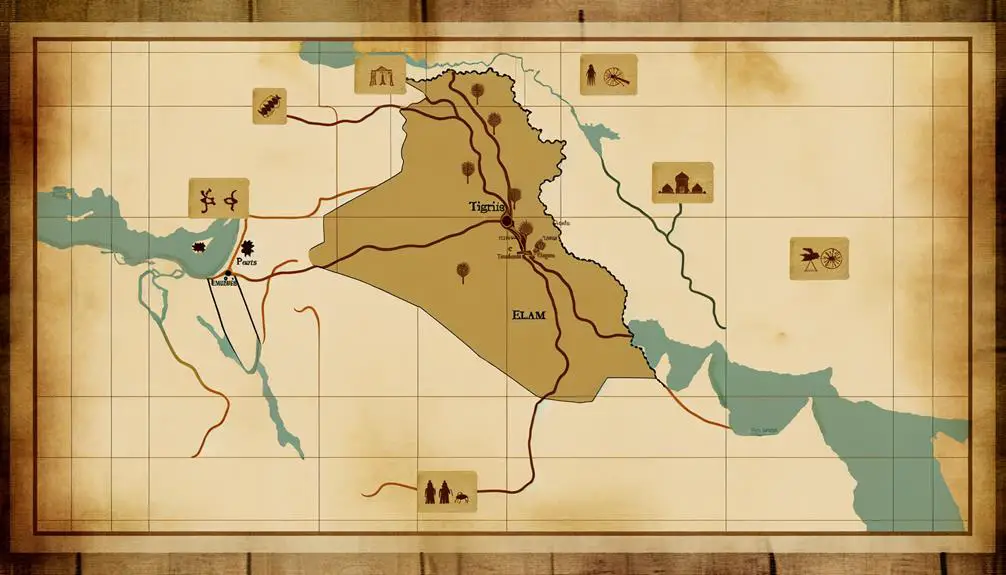
You'll find Elam's legacy intricately woven into the biblical narrative, marked by its significant presence and the prophetic references that highlight its role within a broader divine plan.
Analyzing these mentions, you uncover layers of historical and theological implications, suggesting Elam's influence and eventual fate were of considerable interest to biblical authors.
This exploration sheds light on the complex interplay between geopolitical realities and spiritual convictions in ancient texts, offering insights into how the biblical portrayal of Elam contributes to our understanding of its historical and eschatological significance.
Elam's Biblical Significance
Elam's significance in biblical texts is intricately tied to its depiction as both a nemesis and an ally to the Israelites, reflecting its complex historical interactions. The presence of Elamite artifacts and the mention of trade routes in biblical narratives underscore this multifaceted relationship.
- Elamite artifacts found in Israelite lands highlight the cultural and commercial exchanges between these ancient entities.
- Trade routes facilitated the movement of goods, ideas, and peoples, weaving Elam's story into the broader biblical narrative.
- The depiction of Elamites as formidable warriors in the scriptures mirrors historical accounts of their military prowess.
- Conversely, alliances between Elam and Israel demonstrate periods of mutual respect and cooperation, challenging a simplistic friend-foe dichotomy.
This nuanced portrayal underscores Elam's influential role in biblical history, reflecting its real-world complexities.
Prophetic References to Elam
Reflecting on Elam's multifaceted relationship with Israel, it's crucial to explore its portrayal in biblical prophecy. In these texts, Elam's descendants are often depicted as subject to divine judgment, emphasizing the complex dynamics between divine providence and human history. Such prophetic references serve as historical accounts and theological commentaries, articulating principles of justice, retribution, and redemption within the biblical narrative.
The portrayal of Elam through the lens of divine judgment invites deeper reflection on the role of nations in the divine economy and the ultimate purpose of their existence within the biblical worldview. This approach enriches our understanding of Elam's legacy, highlighting its significance in both historical and spiritual contexts.
Frequently Asked Questions
How Has Modern Archaeology Changed Our Understanding of Elam's Location and Boundaries Compared to Traditional Biblical Interpretations?
Modern archaeology has reshaped understanding of Elam's exact location and boundaries. This is through analysis of Elamite pottery styles and study of geographic climate shifts. These scientific approaches have provided a more detailed and accurate depiction than traditional biblical interpretations alone.
You now know that Elam's reach and influence were both wider and more varied over time. This underscores the complexity of ancient civilizations and their interactions with their changing environments.
Are There Any Linguistic Connections Between the Elamite Language and the Languages of the Bible, Such as Hebrew or Aramaic?
You might think finding connections between the Elamite language and Biblical tongues like Hebrew or Aramaic is as easy as pie, but alas, it's more like deciphering a cryptic crossword.
Despite the breakthroughs in Elamite script decipherment, establishing a linguistic link to Proto-Elamite culture and the languages of the Bible proves intricate.
Scholars meticulously analyze these ancient scripts, yet the relationship remains as elusive as ever, highlighting the complexity of unraveling our shared linguistic heritage.
How Do Contemporary Scholars Reconcile Discrepancies Between Biblical Narratives and Historical Evidence Regarding Elam?
To reconcile discrepancies between biblical narratives and historical evidence about Elam, contemporary scholars delve into textual criticism and examine cultural influences.
You'll find them analyzing texts in depth, comparing linguistic nuances, and cross-referencing archeological findings.
They're keen on understanding how cultural exchanges might've shaped stories, blending factual history with spiritual narratives.
This approach helps to bridge gaps, offering a more nuanced view of Elam's portrayal in biblical context.
What Role Does Elam Play in Non-Biblical Ancient Texts, and How Does This Compare to Its Portrayal in the Bible?
In non-biblical ancient texts, Elam emerges as a tapestry woven with threads of commerce and spirituality, where Elamite deities stand tall, casting long shadows over the bustling trade routes. This depiction intricately contrasts with its biblical portrayal, where Elam often dances in the background of narratives.
Here, you'll find Elam not just as a geopolitical entity but as a cultural and religious hub, richly layered and significantly more complex than its biblical silhouette suggests.
Can Any Specific Artifacts or Architectural Remains Be Directly Linked to the Narratives Involving Elam Mentioned in the Bible?
You're exploring if artifacts or architectural remains link to Elam's biblical narratives. Specifically, Elamite pottery and trade routes provide tangible connections.
These artifacts, found through archaeological digs, offer insights into the Elamites' daily lives and their interactions with neighboring regions.
The detailed analysis of pottery styles and trade route remnants reveals a complex society that mirrors some biblical descriptions, bridging the gap between historical evidence and biblical accounts of Elam.
Conclusion
You might wonder how Elam, seemingly a minor player in biblical narratives, could wield such influence. Yet, as we've explored, Elam's strategic alliances, rich cultural heritage, and prophetic importance weave it deeply into the fabric of biblical history.
Its legacy, far from being a footnote, is a testament to the interconnectedness of ancient civilizations and their enduring impact on religious texts. Elam's story, embroidered with political intrigue and divine prophecies, enriches our understanding of the Bible's multifaceted tapestry.


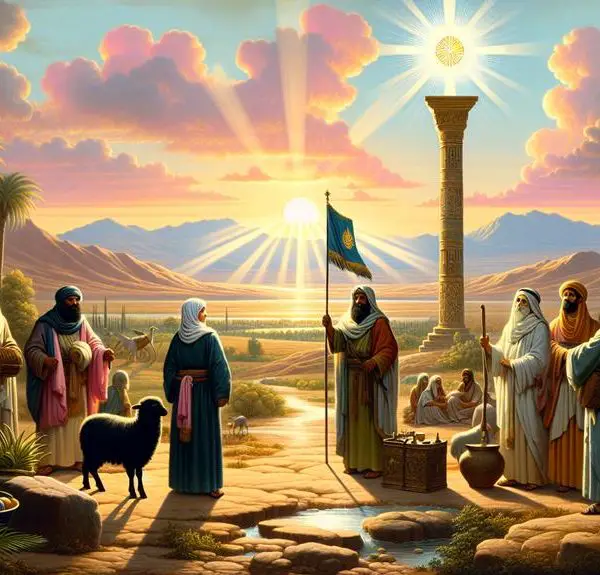
Sign up